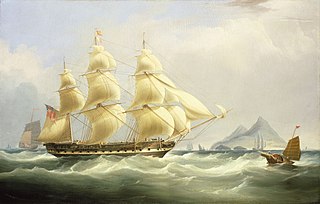Three vessels named Earl Talbot for one of the Earls Talbot served in the 18th and 19th centuries as East Indiamen for the British East India Company (EIC):

Earl Talbot is a title that has been created twice in the Peerage of Great Britain. This branch of the Talbot family descends from the Hon. Sir Gilbert Talbot, third son of John Talbot, 2nd Earl of Shrewsbury. His great-great-great-grandson, the Right Reverend William Talbot, was Bishop of Oxford, of Salisbury and of Durham. His eldest son Charles Talbot was a prominent lawyer and politician. In 1733, he was raised to the Peerage of Great Britain as Lord Talbot, Baron of Hensol, in the County of Glamorgan, and then served as Lord Chancellor of Great Britain from 1733 to 1737.

The East India Company (EIC), also known as the Honourable East India Company (HEIC) or the British East India Company and informally as John Company, Company Bahadur, or simply The Company, was an English and later British joint-stock company. It was formed to trade in the Indian Ocean region, initially with Mughal India and the East Indies, and later with Qing China. The company ended up seizing control over large parts of the Indian subcontinent, colonised parts of Southeast Asia, and colonised Hong Kong after a war with Qing China.
- Earl Talbot (1778 EIC ship) made six voyages to India for the EIC between 1778 and 1793.
- In 1795 the EIC sold the second Earl Talbot to the Royal Navy while she was still on the stocks. The Navy renamed her HMS Agincourt. She became the prison ship HMS Bristol in 1812, and was sold for immediate break-up in 1814.
- Earl Talbot (1797 EIC ship) was launched in 1797. She made one full voyage for the EIC but was lost near China on the outward bound leg of her second voyage with the loss of her entire crew and passengers.
Earl Talbot was launched as an East Indiaman in 1778. She made six voyages for the British East India Company (EIC) between 1779 and 1793. She was sold for breaking up in 1793.

The Royal Navy (RN) is the United Kingdom's naval warfare force. Although warships were used by the English kings from the early medieval period, the first major maritime engagements were fought in the Hundred Years War against the Kingdom of France. The modern Royal Navy traces its origins to the early 16th century; the oldest of the UK's armed services, it is known as the Senior Service.
HMS Agincourt was a 64-gun third-rate ship of the line of the Royal Navy, launched on 23 July 1796 at Blackwall Yard, London. The Admiralty bought her on the stocks from the East India Company in 1796, who had called her Earl Talbot.
| This article includes a list of ships with the same or similar names. If an internal link for a specific ship led you here, you may wish to change the link to point directly to the intended ship article, if one exists. |

